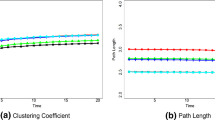Abstract
Inspired by real world phenomena, in this paper, the authors present a power law evolutional network model with degree exponent β < 2. Combinatorial probabilistic method is applied to the theoretical analysis of the presented model. In the proposed model, each time stamp the number of links among a newly added node and old ones follows Poisson distribution with parameter λ and selection probability p. The authors derive exact analytical relationship between the exponent of the power law β, the parameters λ and p. Simulation result is consistent with the exponent β analytical solution. Both theoretical analysis and simulation results show that the presented network evolution model has two obvious real world social network characteristics, degree exponent β < 2 and bending phenomena.
Similar content being viewed by others
References
Watts D J and Strogatz S H, Collective dynamics of small-world networks, Nature, 1998, 393(6684): 440.
Erdos P and Rényi A, On the evolution of random graphs, Publ. Math. Inst. Hung. Acad. Sci., 1960, 5(1): 17–60.
Barabási A L and Albert R, Emergence of scaling in random networks, Science, 1999, 286(5439): 509–512.
Albert R and Barabási A L, Statistical mechanics of complex networks, Reviews of Modern Physics, 2002, 74(1): 47.
Dorogovtsev S N, Mendes J F F, and Samukhin A N, Structure of growing networks with preferential linking, Physical Review Letters, 2000, 85(21): 4633.
Krapivsky P L, Redner S, and Leyvraz F, Connectivity of growing random networks, Physical Review Letters, 2000, 85(21): 4629.
Bollobás B, Riordan O, Spencer J, et al., The degree sequence of a scale-free random graph process, Random Structures and Algorithms, 2001, 18(3): 279–290.
Seyed-Allaei H, Bianconi G, and Marsili M, Scale-free networks with an exponent less than two, Physical Review E, 2006, 73(4): 046113.
Broder A, Kumar R, Maghoul F, et al., Graph structure in the web, Computer Networks, 2000, 33(1–6): 309–320.
Medina A, Matta I, and Byers J, On the origin of power laws in Internet topologies, ACM SIGCOMM Computer Communication Review, 2000, 30(2): 18–28.
Redner S, How popular is your paper? An empirical study of the citation distribution, The European Physical Journal B-Condensed Matter and Complex Systems, 1998, 4(2): 131–134.
Jeong H, Mason S P, Barabási A L, et al., Lethality and centrality in protein networks, Nature, 2001, 411(6833): 41.
Leskovec J, Huttenlocher D, and Kleinberg J, Signed networks in social media, CHI. 2010.
Adamic L A and Glance N, The political blogsphere and the 2004 US election: Divided they blog, Proceedi ngs of the 3rd international workshop on Link discovery ACM, 2005, 36–43.
Leskovec J, Lang K, Dasgupta A, et al., Community structure in large networks: Natural cluster sizes and the absence of large well-defined clusters, Internet Mathematics, 2009, 6(1): 29–123.
Richardson M, Agrawal R, and Domingos P, Trust management for the semantic web, ISWC. 2003.
Ebel H, Mielsch L I, and Bornholdt S, Scale-free topology of e-mail networks, Physical Review E, 2002, 66(3): 035103.
Jovanovic M J, Scalability issues in large peer-to-peer networks — A case study of gnutella, Technical Report, Univ. of Cincinnati. 2001.
Newman M E J, Scientific collaboration networks I. Network construction and fundamental results, Physical Review E, 2001, 64(1): 016131.
Cancho R F and Solé R V, The small world of human language, Proceedings of the Royal Society of London B: Biological Sciences, 2001, 268(1482): 2261–2265.
Newman M E J, The structure and function of complex networks, SIAM Review, 2003, 45(2): 167–256.
Zhongbao K and Changshui Z, Reply networks on a bulletin board system, Physical Review E, 2003, 67(3): 036117.
Guo J L and Wang L N, Scale-free networks with the power-law exponent between 1 and 3, Acta Phys. Sin., 2007, 56(10): 5635–5639.
Li J, Zhou S, Li X, et al., An insertion-deletion-compensation model with Poisson process for scale-free networks, Future Generation Computer Systems, 2018, 83: 425–430.
Wu J, Tan Y, Deng H, et al., Some properties of scale-free networks with scaling exponent, Journal of Systems Science Mathematical Sciences, 2008, 28(7): 811–821.
Liu Y Y, Slotine J J, and Barabási A L, Controllability of complex networks, Nature, 2011, 473(7346): 167.
Menichetti G, Dall Asta L, and Bianconi G, Network controllability is determined by the density of low in-degree and out-degree nodes, Physical Review Letters, 2014, 113(7): 078701.
Fan C, Lu L, Dewey T G, et al, Duplication models for biological networks, Journal of Computational Biology, 2003, 10(5): 677–687.
Shao J, Havlin S, and Stanley H E, Dynamic opinion model and invasion percolation, Physical Review Letters, 2009, 103(1): 018701.
Adamic L A, Lukose R M, Puniyani A R, et al., Search in power-law networks, Physical Review E, 2001, 64(4): 046135.
Toroczkai Z and Bassler K E, Network dynamics: Jamming is limited in scale-free systems, Nature, 2004, 428(6984): 716.
Author information
Authors and Affiliations
Corresponding author
Additional information
This research was supported by the National Natural Science Foundation of China under the Grant Nos. 71661001, 61473284, the Key Program of National Natural Science Foundation of China under Grant No. 71731002.
This paper was recommended for publication by Editor CHEN Jie.
Rights and permissions
About this article
Cite this article
Li, Z., Tang, X. A Study on Scale Free Social Network Evolution Model with Degree Exponent < 2. J Syst Sci Complex 33, 87–99 (2020). https://doi.org/10.1007/s11424-020-8007-5
Received:
Revised:
Published:
Issue Date:
DOI: https://doi.org/10.1007/s11424-020-8007-5




